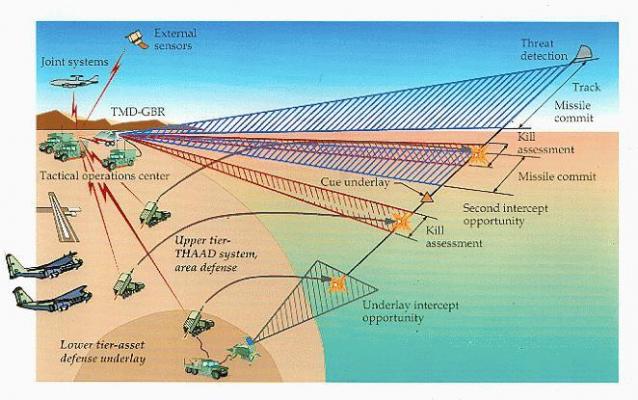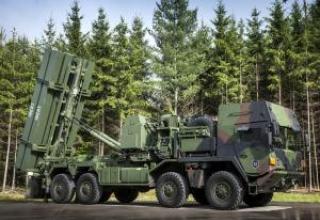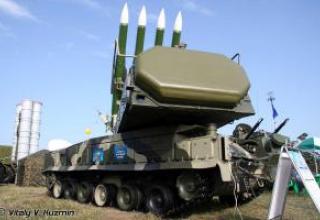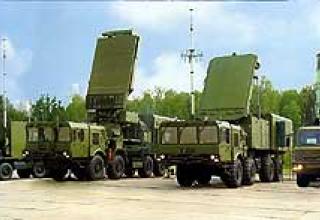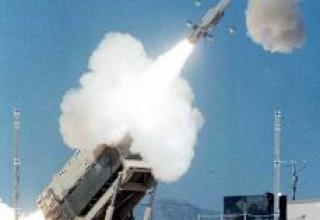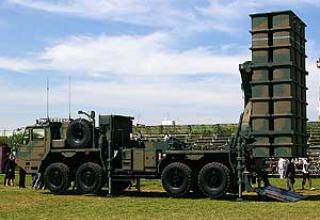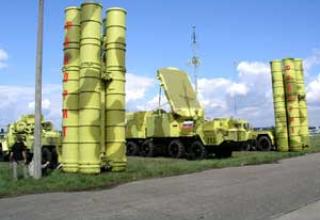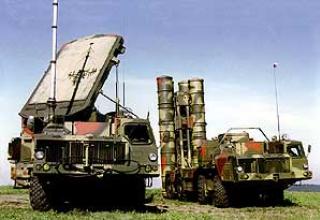The THAAD (Terminal High Altitude Area Defense, formerly Theater High Altitude Area Defense) mobile ground-based missile system is designed for high-altitude zaatmosheric intercept of medium-range missiles during the creation of a zone-based missile defense system in the theater of war (TVD).
The general contractor is Lockheed Missiles & Space Co.
The plan to create a missile defense system at TVD included the following stages of work:
In the first phase (1993-1995) the main efforts were concentrated on completion of modernization and testing of the Patriot SAM system. This system is capable of engaging ballistic missiles at ranges up to 40 km and altitudes of about 20 km. Further upgrade of the Patriot PAC-3 systems is linked to the use of Erint anti-missile systems, which have high accuracy. To protect Marine Corps units from tactical missile strikes, it was planned to complete modernization of the Improved Hawk SAM system with the new AN/TPS-59 radar. The upgraded Aegis shipborne SAMs using Standard-2 SAMs were assigned to cover the coastal UA from missile strikes.
In addition, the combat control system was upgraded, which had limited capabilities to detect, process and transmit data on the ballistic missile launch and calculate the trajectory of their flight. To that end, the tactical information processing and communications system has been improved so that it can use data from the Imius space detection system. The information it receives makes it possible to calculate the launch point, flight path, estimated ballistic missile impact points with greater accuracy and to transmit the necessary information to missile interceptor radars. Work was carried out to upgrade the SPY-1 ship's radar, which should provide detection and tracking of ballistic missiles, as well as facilities that are part of the Air Force (Awaks and Gistar control systems).
The second phase (1996-1999) focused on the development and testing of the THAAD ABM system and the establishment of a zone defence system that would minimize damage in the event of an enemy strike by ballistic missiles equipped with nuclear, chemical or biological warheads. The THAAD mobile missile defense system is designed to engage ballistic missiles at ranges up to 200 km and altitudes up to 150 km. It will be used to create the first boundary of zone missile defense. Characteristics of the THAAD complex allows it to sequentially fire one ballistic missile with two anti-missile systems on the principle of "launch - assessment - launch", that is, the second missile will be launched if the first does not hit the target. If the second missile misses, a Patriot SAM system is put into action, which will receive target designation from the GBR radar for a broken ballistic missile. According to U.S. experts' calculations, the probability of a missile being hit by such a two-stage missile defense system will be more than 0.96. Work is underway to study the possibility of deploying THAAD missiles on ships to combat promising ballistic missiles. In addition, the Diamond Eyes space system is to be deployed to detect launches and escort ballistic missiles.
Composition:
The THAAD anti-missile (see diagram) consists of a combat unit and a motor. The only (detachable) stage is the solid propellant launch engine. The missile is equipped with a traction vector control system and gas-dynamic interceptors in the nose section. The interceptors start to operate shortly after launch and provide control while driving, so the missile's flight control in the starting and middle parts of the trajectory is carried out with the help of a rotating nozzle of the marching solid fuel engine. The characteristics of this engine allow the missile to accelerate to a speed of about 2.5 km/s, allowing the concept of "re-firing" the ballistic target. The missile's tail is a flexible, self-adjustable and adaptable conical stabilizer consisting of movable aerodynamic planes-segments, which are supported by special gas bags. This design solution enhances the stabilizing effect of aerodynamic forces on the missile.
The intermediate compartment connecting the launch accelerator with the combat unit contains a pyrotechnic composition which, by exploding, separates the launch accelerator from the combat unit.
The missile's combat unit is a highly manoeuvrable direct hit interceptor Kill Vehicle (Destroyer Apparatus). This part of the missile is a technically sophisticated device that searches, captures, and then destroys the target, using only the kinetic energy of a high-speed impact. A special fairing covers the interceptor during the atmospheric portion of the flight. This is necessary to reduce aerodynamic drag and protect the homing head window from aerodynamic heat. One of the main features of the interceptor is a gyrostabilized multispectral infrared homing head (IR-HSN) with a sapphire window made on the basis of indium antimonide (operating range 3-5 microns). In addition to IR-GHN, the interceptor is equipped with a command-inertial control system, a computer, a power supply, and a DACS (Divert Attitude Control System) propulsion system for maneuvering and orienting the missile to accurately maneuver its trajectory.
Included in each division:
- GBR (Ground Based Radar) ballistic target detection and tracking radar,
- control station BM/C41,
- launchers (4 pieces) ,
- THAAD missiles (60 pieces) .
The BM/C41 control point is mounted on a multi-purpose vehicle chassis and can function as a TOS (Tactical Operation Station) and LCS (Launcher Control Station) division control point. In the LCS configuration, the control station provides information exchange with other LCSs and information transfer to the TOS. Each battery has several BM/C41 control stations. Their interchangeability provides multiple redundancy of the fire control system, which increases the combat stability of the complex as a whole.
The multifunction GBR radar solves the tasks of detection, tracking, identification and classification of targets, as well as pointing anti-missile missiles at the target in the initial section of the trajectory. The GBR radar uses an active phased antenna array in the X-band with an antenna canvas area of about 10-15 m2 and a number of elements about 24000.
Particular attention in the development of the THAAD radar is paid to the possibility of its quick redeployment and deployment. Advanced technology and microelectronics are used in its production to significantly reduce the weight of the equipment. Thus, if the redeployment of two divisions of Patriot air defense systems to Saudi Arabia during the Gulf War required 73 departures of S-5A, 123 departures of C-141, 14 civil aircrafts and 23 ships, then the redeployment of two divisions of THAAD air defense systems will require only 50 departures of C-141.
Characteristics:
| The length of the rocket, mm | 6170 |
| Maximum rocket body diameter, mm | 370 |
| Start weight,kg | 800 |
| Weight of combat unit, kg | 90 |
| Flight Speed | 3М |
| Maximum target altitude, km | 200 |
| PU height, m | 3.25 |
| PU length, m | 12.0 |
Testing:
Testing of the complex began on April 21, 1995 at White Sands Range and continued with varying success until 1999. Only the ninth launch, on March 29, 1999, demonstrated the performance of the complex as a whole. During this flight, despite the failure of the interceptor's spatial orientation system for 23 seconds of flight and the termination of telemetry data reception for 58 seconds, the interceptor passed in close proximity to the Hera target missile.
During the tenth test launch on June 10, 1999, for the first time, a target simulating a SKAD missile was successfully intercepted and the technical feasibility of such an intercept was confirmed.
On 2 August 1999, during the eleventh test, a target simulating a detachable SCAD-type ballistic missile head in the upper atmosphere was intercepted.
Sources:
- http://lmms.external.lmco.com/thaad
- Federation of American Scientists
- http://lmms.exeternal.lmco.com/newsbureau/pressreleases/1993/9368.html
- http://www.acq.osd.mil/bmdo/bmdolink/html/thaad.html
- "Зарубежное военное обозрение". 1991(12), 1994(4), 1996(6), 1998(8)

